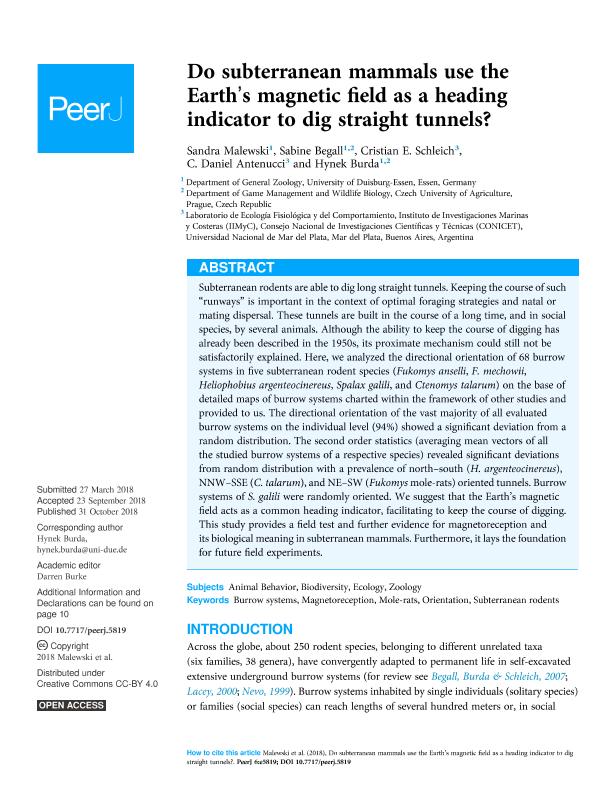Mostrar el registro sencillo del ítem
dc.contributor.author
Malewski, Sandra
dc.contributor.author
Begall, Sabine
dc.contributor.author
Schleich, Cristian

dc.contributor.author
Antenucci, C. Daniel
dc.contributor.author
Burda, Hynek
dc.date.available
2019-11-05T19:26:53Z
dc.date.issued
2018-10-31
dc.identifier.citation
Malewski, Sandra; Begall, Sabine; Schleich, Cristian; Antenucci, C. Daniel; Burda, Hynek; Do subterranean mammals use the Earth’s magnetic field as a heading indicator to dig straight tunnels?; PeerJ Preprints; PeerJ; 6; 31-10-2018; 1-15
dc.identifier.issn
2167-8359
dc.identifier.uri
http://hdl.handle.net/11336/88069
dc.description.abstract
Subterranean rodents are able to dig long straight tunnels. Keeping the course of such “runways” is important in the context of optimal foraging strategies and natal or mating dispersal. These tunnels are built in the course of a long time, and in social species, by several animals. Although the ability to keep the course of digging has already been described in the 1950s, its proximate mechanism could still not be satisfactorily explained. Here, we analyzed the directional orientation of 68 burrow systems in five subterranean rodent species (Fukomys anselli, F. mechowii, Heliophobius argenteocinereus, Spalax galili, and Ctenomys talarum) on the base of detailed maps of burrow systems charted within the framework of other studies and provided to us. The directional orientation of the vast majority of all evaluated burrow systems on the individual level (94%) showed a significant deviation from a random distribution. The second order statistics (averaging mean vectors of all the studied burrow systems of a respective species) revealed significant deviations from random distribution with a prevalence of north–south (H. argenteocinereus), NNW–SSE (C. talarum), and NE–SW (Fukomys mole-rats) oriented tunnels. Burrow systems of S. galili were randomly oriented. We suggest that the Earth’s magnetic field acts as a common heading indicator, facilitating to keep the course of digging. This study provides a field test and further evidence for magnetoreception and its biological meaning in subterranean mammals. Furthermore, it lays the foundation for future field experiments.
dc.format
application/pdf
dc.language.iso
eng
dc.publisher
PeerJ Preprints
dc.rights
info:eu-repo/semantics/openAccess
dc.rights.uri
https://creativecommons.org/licenses/by-nc-sa/2.5/ar/
dc.subject
Burrow Systems
dc.subject
Magnetoreception
dc.subject
Orientation
dc.subject
Subterranean rodents
dc.subject.classification
Otras Ciencias Naturales y Exactas

dc.subject.classification
Otras Ciencias Naturales y Exactas

dc.subject.classification
CIENCIAS NATURALES Y EXACTAS

dc.title
Do subterranean mammals use the Earth’s magnetic field as a heading indicator to dig straight tunnels?
dc.type
info:eu-repo/semantics/article
dc.type
info:ar-repo/semantics/artículo
dc.type
info:eu-repo/semantics/publishedVersion
dc.date.updated
2019-10-24T19:37:51Z
dc.journal.volume
6
dc.journal.pagination
1-15
dc.journal.pais
Estados Unidos

dc.description.fil
Fil: Malewski, Sandra. University Of Duisburg-e;Department Of General Zoology; Alemania
dc.description.fil
Fil: Begall, Sabine. University Of Duisburg-e;Department Of General Zoology; Alemania
dc.description.fil
Fil: Schleich, Cristian. Consejo Nacional de Investigaciones Científicas y Técnicas. Centro Científico Tecnológico Conicet - Mar del Plata. Instituto de Investigaciones Marinas y Costeras. Universidad Nacional de Mar del Plata. Facultad de Ciencias Exactas y Naturales. Instituto de Investigaciones Marinas y Costeras; Argentina
dc.description.fil
Fil: Antenucci, C. Daniel. Consejo Nacional de Investigaciones Científicas y Técnicas. Centro Científico Tecnológico Conicet - Mar del Plata. Instituto de Investigaciones Marinas y Costeras. Universidad Nacional de Mar del Plata. Facultad de Ciencias Exactas y Naturales. Instituto de Investigaciones Marinas y Costeras; Argentina
dc.description.fil
Fil: Burda, Hynek. University Of Duisburg-e;Department Of General Zoology; Alemania
dc.journal.title
PeerJ
dc.relation.alternativeid
info:eu-repo/semantics/altIdentifier/url/https://peerj.com/articles/5819
dc.relation.alternativeid
info:eu-repo/semantics/altIdentifier/doi/http://dx.doi.org/10.7717/peerj.5819
Archivos asociados
